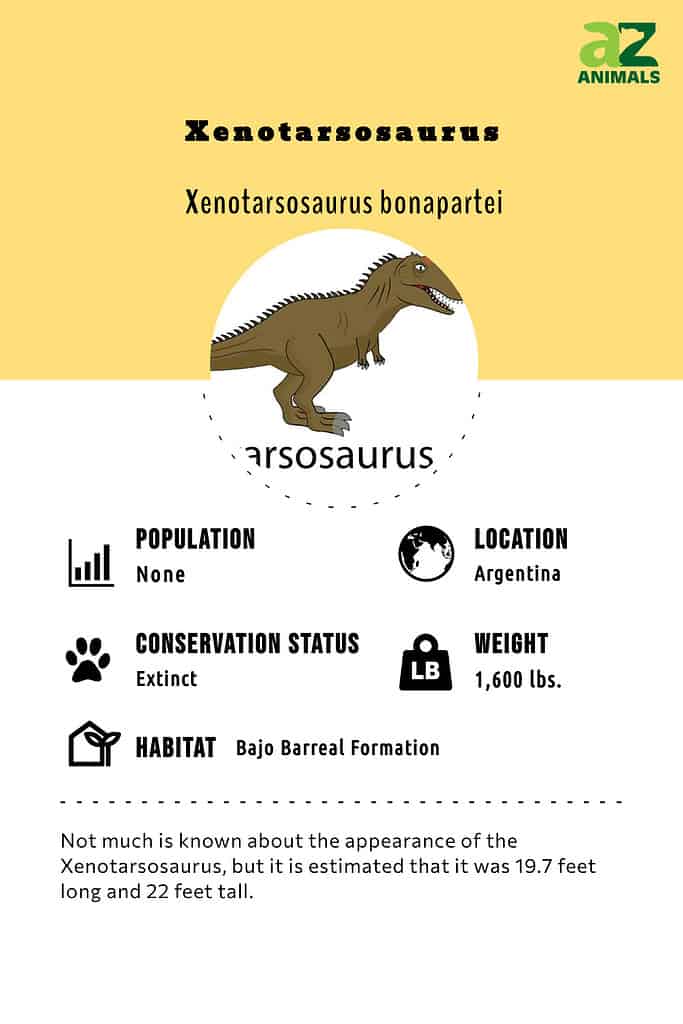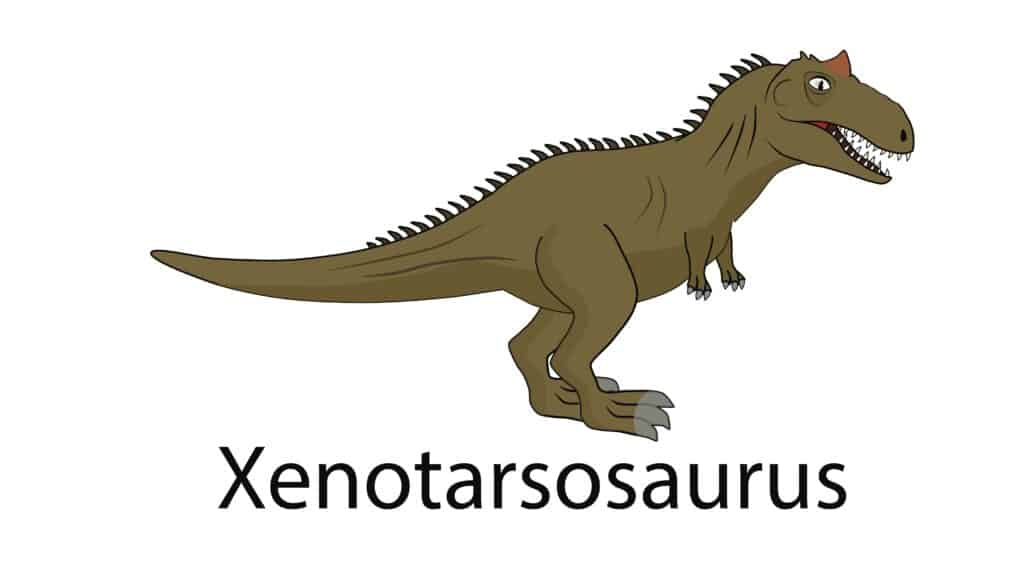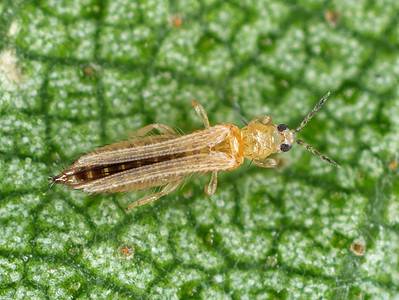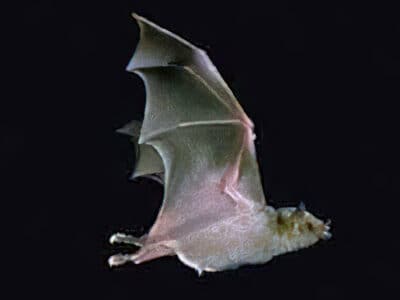Xenotarsosaurus
Xenotarsosaurus bonapartei
Xenotarsosaurus was one of the first fossils discovered in South America's Bajo Barreal formation.
Advertisement
Xenotarsosaurus Scientific Classification
- Kingdom
- Animalia
- Phylum
- Chordata
- Class
- Reptilia
- Family
- Abelisauridae
- Genus
- Xenotarsosaurus
- Scientific Name
- Xenotarsosaurus bonapartei
Read our Complete Guide to Classification of Animals.
Xenotarsosaurus Conservation Status
Xenotarsosaurus Facts
- Prey
- Smaller dinosaurs and other reptiles
- Fun Fact
- Xenotarsosaurus was one of the first fossils discovered in South America's Bajo Barreal formation.
- Biggest Threat
- Other carnivorous dinosaurs that lived around the same time as the Xenotarsosaurus
- Most Distinctive Feature
- This dinosaur had fused ankle bones
- Habitat
- Terrestrial habitat in South America
- Diet
- Carnivore
- Number Of Species
- 1
- Location
- Argentina (South America)
View all of the Xenotarsosaurus images!
With incomplete fossils, there is still much to learn about the Xenotarsosaurus.

Xenotarsosaurus is a genus of dinosaurs that lived in Argentina during the Late Cretaceous Period (100.5–66 million years ago). We do not know a lot about this dinosaur because of the incomplete nature of the fossils. However, it was one of the first dinosaur remains to be discovered in Argentina.
Classification and Scientific Name
The Genus Xenotarsosaurus is, of course, a member of the Clade Dinosauria. It is also a member of the Clades Surischia and Theropoda and the extinct Family Abelisauridae. Xenotarsosaurus was placed in the Family Abelisauridae based on similarities between the rear legs of this dinosaur and that of the abelisaurid Carnotaurus—a dinosaur genus also from South America’s Late Cretaceous Period.
The generic name Xenotarsosaurus is from the Greek words “Xenos,” which means strange, and “tarso,” which stands for tarsus (referring to the ankle bones), and saurus, which means lizard. The name refers to the exceptional build of this dinosaur’s ankle bone which was completely fused. Only one species of this group has been identified so far. The species name, bonapartei, honors Argentinian paleontologist José Fernando Bonaparte.
Description and Size
Not much is known about this dinosaur’s appearance due to the incomplete nature of the fossils found. Since no cranial bones have been found so far, scientists don’t have sufficient information to describe the dentition of this dinosaur. However, recent estimates suggest that it might have weighed about 1,654 lbs. (750 kg) and was about 19-26 ft. (6-8 m) long) and possibly 10-12 ft. tall. The current size estimate is slightly higher than previous estimates of 18 ft., and a weight of 948 lbs. that scientists assigned in 2016.

xenotarsosaurus
©dukanguyen/Shutterstock.com
Diet
Like the Carnotaurus, Xenotarsosaurus was most likely a predator. Experts think it might be one of the main predators of the Bajo Barreal Formation. This means it preyed on smaller dinosaur species like the hadrosaurid Secernosaurus, and titanosaurian sauropods such as Drusilasaura.
Habitat
Xenotarsosaurus was one of the first fossils discovered in South America’s Bajo Barreal Formation. At the time, the formation was considered to be of Campanian Age. However, a more recent revision of the formation’s age shows that it dates back to the Cretaceous’s Cenomanian/Turonian stages. It is difficult to tell the exact nature of the Xenotarsosaurus‘ habitat during the Late Cretaceous. However, we know the climate in Argentina at the time was warmer than present-day.
Threats and Predators
Xenotarsosaurus was a dominant dinosaur in its habitat. This means it did not have a lot of natural enemies or predators. Instead, it preyed on other dinosaurs that shared the same habitat. Possible threats were other carnivorous dinosaurs that might have competed for the same food source.
Discoveries and Fossils
Geologist Juan Carlos Sciutto discovered fossils of the Xenotarsosaurus at a location about six kilometers north of the Ocho Hermanos ranch in Argentina’s Chubut province. The site was fossil-rich and included many theropod fossils, including that of the Xenotarsosaurus.
Another team led by paleontologist José Fernando Bonaparte recovered more bones from the same formation. The discovery included two anterior dorsal vertebrae and a right hind limb. Experts believe both finds belong to the same dinosaur. It wasn’t until 1986 that paleontologists published a complete description of the fossil and assigned the name Xenotarsosaurus bonapartei to the new species.
The generic name is based on the structure of the hindlimb of the fossil. Even though the dinosaur had a fused ankle, scientists discovered that it shared similarities with the Carnotaurus. Based on this, they grouped the dinosaur as an abelisaurid. However, some scientists suggest an alternative classification as an indeterminate neoceratosaurian theropod.
Extinction
Xenotarsosaurus lived about 70-65 million years ago during the Late Cretaceous Period. The exact cause of this dinosaur’s extinction is unknown. However, considering the duration it lived, it might have died off with the rest of the land-dwelling dinosaurs at the end of the Cretaceous. The Cretaceous–Paleogene extinction event, which occurred 66 million years ago, led to the extinction of up to three-quarters of life on earth and ended the age of the dinosaurs.
Similar Animals to the Xenotarsosaurus
Similar dinosaurs to the Xenotarsosaurus include:
- Carnotaurus — This is a genus of theropod dinosaur that lived from about 71 to 69 million years ago. It lived in South America around the same time as the Xenotarsosaurus, and both genera of dinosaurs showed widespread similarities.
- Ekrixinatosaurus — This is the largest Abelisaurid dinosaur to have ever lived. With a length of up to 32.8 ft, it was significantly larger than the Xenotarsosaurus.
- Austrocheirus — This is an extinct genus of theropod dinosaur. Scientists have dated fossils of this dinosaur back to the Cenomanian epoch of the Cretaceous Period, which means it lived about 96 million years ago.
Related Animals
View all 13 animals that start with XXenotarsosaurus FAQs (Frequently Asked Questions)
When was the Xenotarsosaurus alive?
Xenotarsosaurus was thought to come from the Campanian of the Cretaceous (about 100.5–66 million years ago).
How big was Xenotarsosaurus?
It has been challenging to estimate the size of the Xenotarsosaurus due to the incomplete nature of the fossils discovered so far. However, based on recent estimates, scientists think this dinosaur was about 19.7 ft (6 meters) long and 22 ft (6.7 m) tall. It would have weighed about 1,654 lbs (750 kg).
Where did the Xenotarsosaurus live?
Xenotarsosaurus lived in South America. Fossils of this Cretaceous Period dinosaur were found in the Bajo Barreal Formation along with some other theropod dinosaur fossils. This formation is located in the Golfo San Jorge Basin in the Chubut province of Argentina.
Is the Xenotarsosaurus the same as the Carnotaurus?
Both dinosaurs are theropods, and they belong to the same family. They also lived in South America around the same time. However, the Carnotaurus was a separate genus. They also differ slightly in their appearance. While the Carnotaurus was a giant dinosaur, the Xenotarsosaurus was medium-sized.
Thank you for reading! Have some feedback for us? Contact the AZ Animals editorial team.
Sources
- Kidadl, Available here: https://kidadl.com/facts/dinosaurs/xenotarsosaurus-facts
- Prehistoric Wildlife, Available here: http://www.prehistoric-wildlife.com/species/x/xenotarsosaurus.html
- Wikipedia, Available here: https://en.wikipedia.org/wiki/Xenotarsosaurus
















